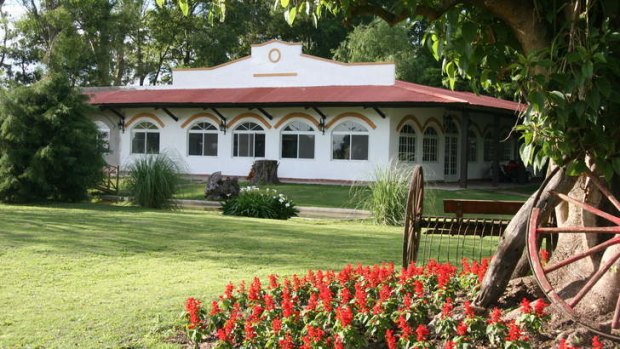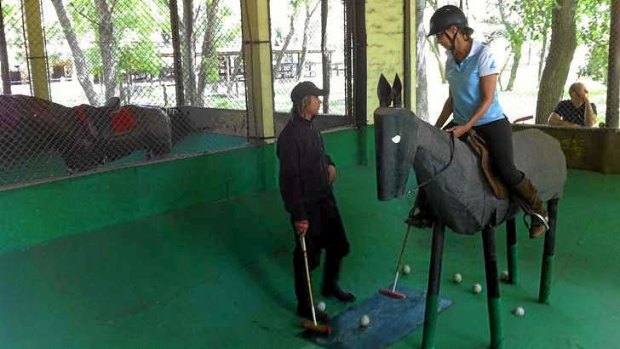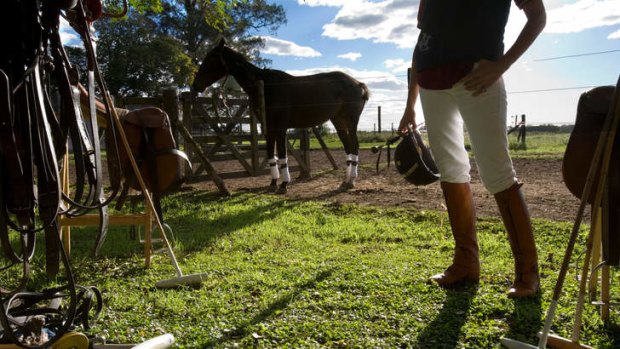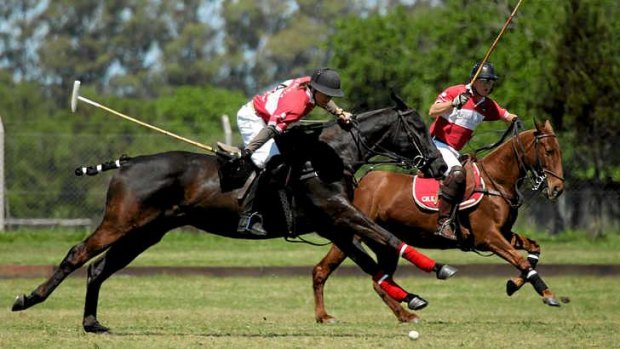
Recreation room at Estancia don Manuel.Credit: Julie Miller
Learning the art of playing polo doesn't have to cost a fortune, writes Julie Miller.
'Sex - the poor man's polo," wrote American playwright Clifford Odets. And indeed, the oldest team sport in the world (having been invented by the Persians in the sixth century BC) is one of the fastest, most dangerous and adrenalin-pumping games imaginable, demanding not only concentration, a good swing, flexibility and upper-body strength, but also riding skills and nerves of titanium.
It is not called "the game of kings" for nothing; requiring a string of ponies to play competitively, it helps to have the bank account of British royalty.

You need all the right gear.
Polo is often dismissed as an elitist pastime, far beyond the reach of the average sports enthusiast. Except in Argentina. Here, in a nation where horsemanship is next to godliness, polo is followed by the masses, attracting crowds of up to 20,000 at top-level tournaments.
Argentina has more top-level 10-goal handicap players than any other country and currently boasts nine of the top 10 professional players - most of them ridiculously good-looking and married to supermodels. For some reason Argentines simply do it better.
Which is why polo aficionados - including amateur teams, aspiring players and even raw beginners like myself - head to Buenos Aires to learn the sport from the best of the best.

Riding the wooden horse.Credit: Alamy
There's another factor that's lured me to Argentina - affordability. For not much more than the price of a two-hour polo lesson in Australia, I can spend the night at a luxurious, all-inclusive polo estancia, relaxing in comfortable surrounds, feasting on hearty Argentine cuisine and receiving personal tuition both on and off the field.
By the end of a week's vacation, I should have the competence to play a chukka - a feat that might take months of bank-breaking training back home.
For my introduction to the sport, I'm visiting Estancia Don Manuel, 20 minutes from Buenos Aires airport on the arid flats of the pampas. This is polo heartland; the region is dotted with breeding establishments, while the No. 1 player in the world, Adolfo Cambiaso, owns the neighbouring property.

Polo practice on the field.
Set in 6.5 hectares of tree-studded parkland, the estancia is the family home of Emiliano Blanco, a charming, boyishly handsome (of course) polo professional who managed a club in the US, umpired professionally and trained polo ponies before turning his hand to hospitality. There are five comfortable en suite bedrooms in the sprawling main house, with another five in outbuildings; there's also a club room and gym, expansive dining quarters and a sparkling pool, where I meet my fellow guests and playmates.
Dominating the bonhomie is a polo team from Bern in Switzerland - young, fit and, of course, good-looking. I'm definitely seeing a trend here. There is also a family from Brazil, two rambunctious teenage boys perhaps the next generation of superstars. Rounding out the group is a young British woman with aspirations of joining a team in London when she returns from a working stint in Saudi Arabia.
"How long have you been playing polo?" a Swiss team member asks me as we soak up the afternoon rays on sunbeds.
"Ummm ... I played elephant polo once," I reply. "Does that count?" Blank look. Obviously not. "I do ride, though," I hurriedly add, trying not to appear too pathetic.
But pathetic I clearly am, as my first "stick and ball" session reveals. First, I have to throw away every horse-riding rule I've ever learnt, from my position in the saddle to the way I hold the reins.
In polo, you ride one-handed, steering by applying pressure to the horse's upper neck. For someone trained in the English pony club system, it feels foreign.
"The English style is all about stopping your horse," Emiliano instructs me. "Here, it's about giving your horse its head." That's an understatement. Argentine polo ponies - a cross of thoroughbred and tough, local Criollo bloodlines - know two paces: walk, and flat-out. Their power and speed is explosive; their ability to turn on a dime disconcerting.
Keeping in mind my inexperience, we start out slowly, tapping the ball along the field at a walk. Unfortunately, even that proves to be a challenge - I seem to have an uncanny ability to overshoot the mark, with a total lack of eye-hand co-ordination.
"OK," Emi finally concedes. "It's into the cage for you." The what?
"The cage" is where every polo player starts - on a wooden horse, learning to swing the mallet. "You need to twist your left leg in the stirrup and bring your left shoulder over the horse's neck towards the ground," Emi says as I perch up on my Trojan pony in the wired compound. "That way you can get a clean swipe at the ball."
Miracle of miracles, it works. Using my mallet like a pendulum, I hit ball after ball, belting it firmly into a net with a satisfying "thwack". After a couple of hours on my stationary mount, I literally seem to be getting into the swing of things. Later, we take my new skills back on to the field.
I have improved considerably and can now move along at a slow canter and make contact with the ball. My arm aches, my collarbone is bruised from carrying the mallet, but "white ball fever", as they call it, has definitely set in. It may be the start of a very expensive addiction.
The writer was a guest of Estancia Don Manuel.
TRIP NOTES
MORE INFORMATION
GETTING THERE
LAN Airlines has a fare to Buenos Aires for about $2587 low season return from Sydney including tax. You fly to Santiago (about 16hr including transit time in Auckland) and then to Buenos Aires (1hr 50min); see lan.com, phone 1300 558 129. Melbourne passengers pay about $100 more and fly Qantas to Sydney or Auckland to connect. Australians must pay a reciprocity fee before arrival at migraciones.gov.ar.
STAYING THERE
Accommodation at Estancia Don Manuel costs $US295 ($317) a night for players, $US165 a day for non-players. This includes three meals a day, polo tuition, bar, airport transfers, , laundry services and gym sessions. Ranch days, where you learn about Argentina estancia life, ride horses and watch a demonstration polo match, are available. See estanciadonmanuel.com.
Sign up for the Traveller Deals newsletter
Get exclusive travel deals delivered straight to your inbox. Sign up now.